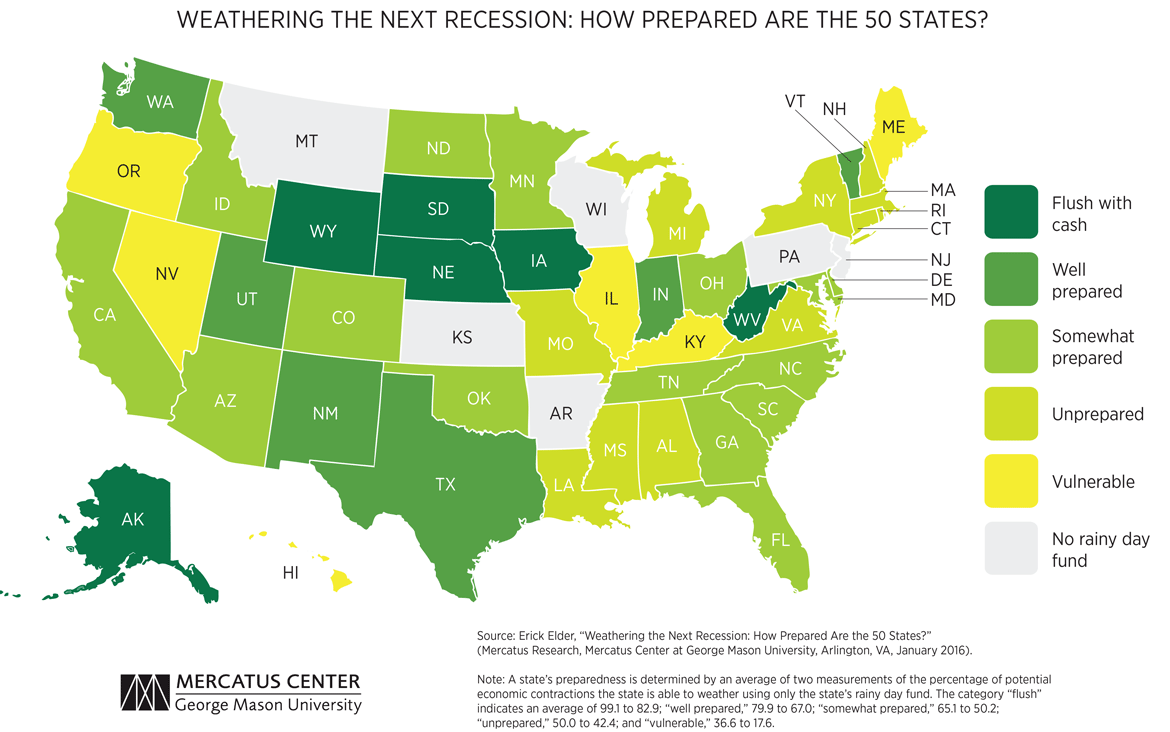- | Housing Housing
- | Research Papers Research Papers
- |
Weathering the Next Recession
How Prepared Are the 50 States?
When recessions strike, state governments must often contend with revenue shortfalls resulting from declines in overall economic activity. Because many states have balanced budget requirements, falling revenues often mean states must raise taxes, cut spending, or do both. Most states have rainy day funds to smooth state spending across business cycles and reduce the need for tax hikes or budget cuts during recessions. Even with historically high rainy day fund balances before the Great Recession, many states did not have enough saved to avoid cutting spending or increasing taxes in 2009 and 2010. The rapid exhaustion of rainy day funds during the Great Recession raises the question of how well states have prepared for the next recession.
A new study for the Mercatus Center at George Mason University examines the current condition of state rainy day funds from across the United States. By comparing the balances of individual states’ rainy day funds as a percentage of their annual revenue with various levels of potential revenue shortfalls based on recession severity, the study finds that the vast majority of states have not saved enough to weather the average decline in revenue associated with the full range of potential recessions

Data and Empirical Strategy
Credit rating agencies and professional organizations for state policymakers have suggested that states should aim to save enough to cover between 5 percent and 16.7 percent of their annual spending or revenue, but this one-size-fits-all solution ignores variances in business cycle duration and severity among the states. This study accounts for differences among the states by using state-level public finance data and economic indicators to create potential distributions of savings goals for each state.
Key Findings
To understand how prepared a state is to handle revenue shortfalls during a recession, policymakers need to answer two key questions: What target level of savings would be an appropriate buffer for revenue declines, and what proportion of possible recessions could the state weather with its current level of savings?
What Target Level of Savings Is Best?
- Most recessions are short, but long recessions are disproportionately harmful. The target level of savings for a state should be equivalent to its expected revenue shortfall for the average recession. Most recessions are shorter than the average, and longer recessions are much more harmful, meaning that the expected revenue shortfall for the average recession is higher than the expected revenue shortfall for most recessions.
- States should save enough to cover at least three out of every four recessions. Most states’ expected revenue shortfall for the average recession is near the expected revenue shortfall for the 75th percentile of recessions. In other words, to be prepared for the average recession, states should save enough to cover three out of every four recessions.
Which States Are Most Prepared?
Alaska, West Virginia, South Dakota, Nebraska, and Wyoming are the top five most prepared states for the next recession, based on the ability of their respective rainy day funds to cover any expected revenue shortfalls. Each of these states is prepared to cover its entire revenue shortfall in well over 75 percent of expected recession scenarios using its rainy day fund.
Which States Are Least Prepared?
Six states—Arkansas, Kansas, Montana, New Jersey, Pennsylvania, and Wisconsin—are tied for being the least prepared for handling expected revenue declines during future recessions. None of these states has a rainy day fund, meaning any future revenue shortfalls would have to be covered through spending cuts or tax hikes. Including general fund balances as an additional buffer against potential revenue shortfalls improves Wisconsin’s, Montana’s, and Kansas’s preparedness measure, but Arkansas, New Jersey, and Pennsylvania remain among the least prepared states, joined by Maine and Illinois.
Policy Recommendations
- Contribute more to rainy day funds. To avoid spending cuts or tax hikes during the average recession, states that currently do not have enough saved in their rainy day funds will need to increase the accumulated savings in their respective funds. The data tables presented in the study allow state policymakers to pick their own savings goals and estimate how well prepared their state would be for a given recession under the new goal.
- Enact rules governing the use of rainy day funds. State legislators can do more to ensure fiscal stability for their states by adopting requirements for deposits made to their rainy day funds and by setting strict rules about withdrawals. States that have already adopted such rules have, on average, lower spending volatility across years than states without such rules.